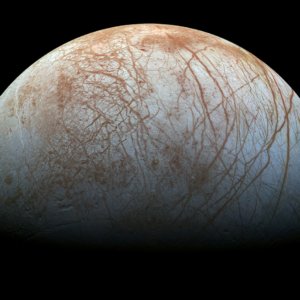 1
1

Great pyramid in Cholla
 17. 04. 2024
17. 04. 2024



 1
1

 17. 04. 2024
17. 04. 2024
 6
6

 16. 04. 2024
16. 04. 2024
 8
8

 15. 04. 2024
15. 04. 2024
 1
1

 04. 12. 2019
04. 12. 2019

Water is life. Water is the most important ingredient on the list of substances that allow life to blossom. Astronomers have gained a lot of evidence that liquid water is located under the icy surface of Europe. They even thought that water could occasionally burst into the surroundings in the form of large geysers. But it was not yet possible to confirm its presence in these geysers by detecting water molecules.
NASA has now confirmed water vapor detection on Europe's Jupiter ice moon. NASA's Maryland Space Flight Center, Maryland, published its study in a magazine Nature Astronomy.
“Confirming water vapor over Europe helps scientists better understand the internal functioning of the moon. For example, it supports the idea that there is a dense ocean under the ice of the moon that is twice as large as Earth, ”NASA said in a Monday statement.
Astronomers took measurements with one of the largest telescopes ever - the WM Keck Observatory on Mauna Kea, Hawaiian Peak. Europa was watched from February 2016 to May 2017. A specific infrared signal was detected, which was due to a spur of water vapor into space in mid-April 2016.
2 360 kilograms of water per second was recorded, a quantity that would fill the Olympic swimming pool in minutes. “Throughout the solar system there are basic chemical elements (carbon, hydrogen, nitrogen, oxygen, phosphorus, and sulfur) and energy sources - two of the three requirements for life. Liquid water, the third source, is difficult to find outside the Earth, ”said Lucas Paganini, head of the study and planetary scientist NASA. He added that although scientists had not yet detected the liquid water on Europa, an even better finding was made - that water vapor.
Finding water vapor can be one of many other amazing discoveries on the moon Europa. Between 1995 and 2003, Galileo made a significant finding. Thanks to her mission, astronomers have detected Jupiter's magnetic field disturbances around Europe. Scientists explained that the cause could be the presence of conductive liquid, possibly saltwater under the ice.
Before these discoveries in 2003, NASA used the well-known Hubble telescope to observe Europe, recording oxygen and hydrogen (both forming water). A few years later, the Hubble Telescope helped another team of scientists find further evidence of these geysers. Their silhouettes then appeared as the moon passed in front of its planet. "Direct water vapor detection over Europe is a key confirmation of our earlier detection of individual elements and shows the thinness of water jets in this ice world," said Lorenz Roth, astronomer and physicist at the KTH Royal Institute of Technology in Stockholm, Sweden. It was he who led the research in 2013 and co-authored the current study.

All of these detections only measured the water components under the moon's icy surface. Finding water on one of the cosmic bodies is very difficult. Modern-day probes, too, have limited possibilities of discovering water in space, and when using ground-based telescopes, measurement errors can occur due to moisture in the Earth's atmosphere. This study took into account possible errors, so in this case, scientists secured a computer model that simulated conditions in the Earth's atmosphere, allowing them to distinguish the results caused by water in the atmosphere from water in Europe.
There is another Europa Clipper in preparation to confirm all the astronomers' observations and to provide answers to the Moon's external and internal functioning. According to scientists, Europa is the best chance of finding life outside the Earth, and this is what Europa Clipper can confirm in the case of the ice kingdom of Jupiter.
As we wrote above, water means life. Where there is water, it is best to focus your efforts on finding life outside the earth.